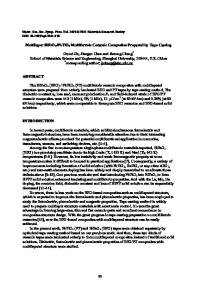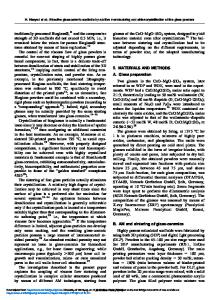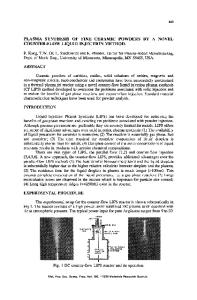Tape Casting Using Fine Ceramic Powders
- PDF / 1,261,364 Bytes
- 6 Pages / 420.48 x 639 pts Page_size
- 69 Downloads / 483 Views
TAPE CAS70T
G U$SllG FUM~E CERAMOC POWDJERS
DAVID S. WILKINSON, KEVIN P. PLUCKNET'F AND CARLOS H. CACERES Dept. of Materials Science and Engineering, McMaster University, Hamilton, Ontario L8S 4L7, CANADA. ABSTRACT
Tape casting technology has been developedfor the productionof ceramic composites using fine powders of alumina and zirconia with an average particle size in the range 0.25-0.3 Ism. These powders require careful control of the dispersant/solids ratio in order to minimize the slip viscosity, and to prevent the rejection of excess dispersantduring solvent evaporation. In this regard phosphate ester has been found to be an effective dispersant. The choice of solvent is also important, with a non-polar solvent exhibiting moreforgiving behaviour. The use of such fine powders lowers the solids loadingpermitted in the tape casting slip to about 22 vol. %, with a resulting green density of less than 54% of theoretical. However, high sintered densities can be achieved in both single tapes and laminates. Constraintsimposed on the tape during solvent evaporation lead to a difference in green density within the tapes, and strategies need to be developed to counteract this. INTRODUCTION
Tape casting offers several potential advantages as a technique for green body fabrication of structural ceramics. First, laminates which are made from the tapes can contain material of varying composition in each layer. Thus microstructural engineering to achieve a desired function is possible. Second, tape casting enables very good orientation of anisotropic particles (e.g. whiskers and platelets). Thus aligned composite systems can be developed. Finally, both tapes and laminates are amenable to green state forming. Thus a range of complex shaped components are possible. In this program we have focused on the development of dense composite laminates using fine starting powders. Such materials are capable of being superplastically formed into shapes which cannot easily be made in the green state, with excellent dimensional control. The use of fine powders in tape casting presents a number of challenges which increase in severity as particle size decreases. Velamakanni and Lange [1] have shown that slip viscosity increases with decreasing particle size for a given solids loading. Moreover, large surface area powders require more dispersant. Both of these effects require a decrease in solids loading in the casting slip, with a subsequent loss of green density. It is therefore imperative that excellent control over the process be achieved in order to optimize sinterability and avoid the production of large shrinkage-induced defects. EXPERENTAL
The study presented here is based on the fabrication of A120 3 tapes with up to 30 vol. % ZrO 2. The powders used (Sumitomo AKP-50 A120 3, and Tosoh TZ-0 and TZ-2Y ZrO 2) were chosen because of their high purity and fine particle size (see Table I). For comparison, tapes were also made using a coarser alumina powder, namely Alcoa A16-SG.
Mat. Res. Soc. Symp. Proc. Vol. 249. 01992 Materials R
Data Loading...











